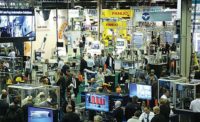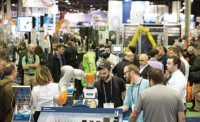Thousands of manufacturing professionals from 45 states and 35 countries saw the latest robots, fastening tools, software and automation at the 11th annual ASSEMBLY Show, which was held Oct. 24-25 at the Donald E. Stephens Convention Center in Rosemont, IL.
The show featured 223 exhibitors spread across more than 62,000 square feet of floor space.
“We were thrilled to bring the industry together to provide manufacturing professionals with everything they need to adapt to new challenges, expand into new markets, and streamline their businesses to grow more efficient,” says Bill DeYoe, publisher of ASSEMBLY, which produces the event. “Hundreds of people attended our expanded conference program, which featured dozens of educational sessions on the latest technology, including AI, robotics and Industry 4.0.
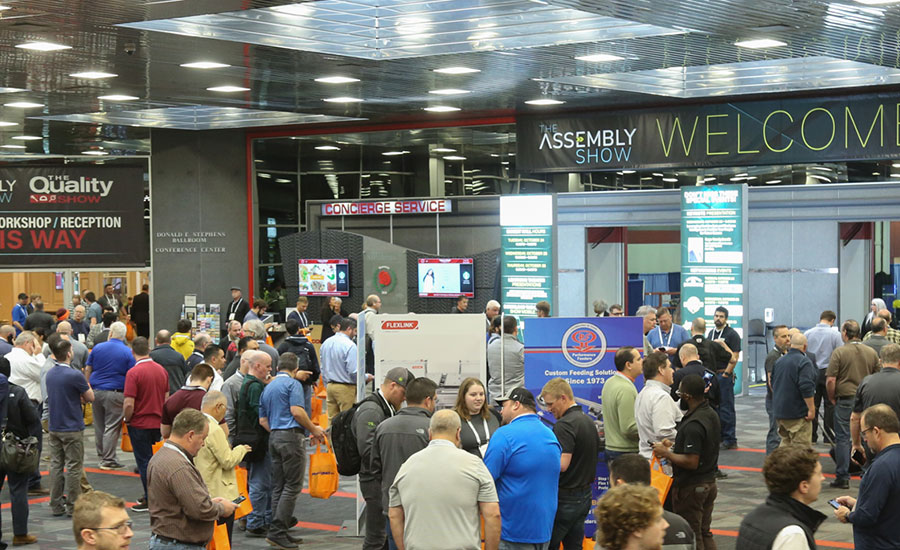
Thousands of manufacturing professionals saw the latest robots, fastening tools, software and automation at the 11th annual ASSEMBLY Show. Photo by Brad Meese
“On the last day of the event, we were pleased to donate $3,000 to the Susan G. Komen Foundation as part of our first ever Pink Out Day to support breast cancer research. We have never been prouder to be part of this incredible community and support an important cause.”
More than 4,800 industry professionals from across the United States and around the world registered to attend the show. Attendees came from every industry covered by ASSEMBLY magazine, including such companies as AGCO, Apple, BAE Systems, Baxter Healthcare, Bobcat, Boeing, Ford Motor Co., GE Healthcare, Hino Motors, Hitachi Automotive, Honda, Hu Friedy, Kohler, L3 Harris, Motorola, Northrop Grumman, Phillips-Medisize, Tenneco, Toyota and Trane.
The event kicked off with a full day of 24 educational sessions that attracted hundreds of attendees. Presentations covered myriad topics, including artificial intelligence, automated assembly, robotic welding, workforce management, and design for assembly. In addition, Sammy Obara, lean manufacturing guru and a partner in the management consulting firm Honsha Associates, led a three-hour workshop on creating a culture of kaizen.
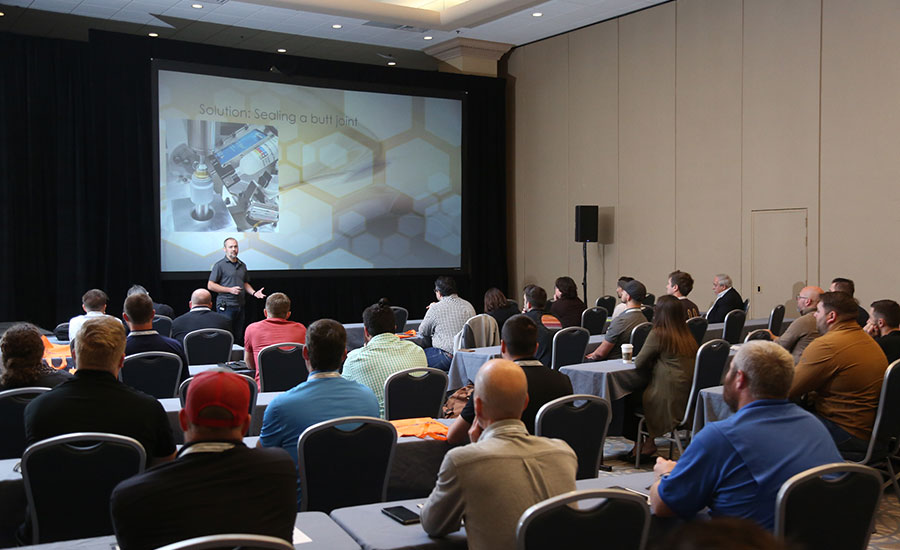
The ASSEMBLY Show kicked off with a full day of educational sessions. Presentations covered myriad topics, including artificial intelligence, automated assembly, robotic welding, workforce management, and design for assembly. Photo by Brad Meese
Editors from ASSEMBLY led dozens of attendees on guided exhibit hall tours. The tours gave attendees a sampling of exhibitors in six technology categories: lean manufacturing, robotics, fastening tools, conveyors and material handling, plastics assembly, and manufacturing software.
Subject matter experts from 12 exhibitors gave presentations at the show’s Learning Theaters in the exhibit hall. The sessions, which averaged 16 attendees, covered topics such as artificial intelligence, augmented reality, automated guided vehicles, digital transformation, fastening, leak testing, and value stream mapping.
During the opening night “Taste of Rosemont” reception, high school students from PWNAGE Robotics team 2451 demonstrated the various robots they built, all of which use technology that is applicable for assembly. The team is based in St. Charles, IL, sponsored primarily by exhibitor Genesis Automation and competes in FIRST (For Inspiration and Recognition of Science and Technology) Robotics competitions internationally to gain real-world engineering experience.
Keynote Discusses Data Analytics
The show’s keynote address was presented by Roger Koenigsknecht, vice president of North American Connection Systems for Lear Corp. In his role, Koenigsknecht manages some 500 people who design and manufacture Lear’s low- and high-voltage terminals, engineered plastics and components. Among other things, he works hard to ensure that machines and business intelligence software provide Lear with real-time, unfiltered information to help the company make sound business decisions.
Koenigsknecht explained how Lear developed its own manufacturing execution system it calls the Lear Production System. “Home-grown systems are good, because you can change them and not be charged by a third party,” he says. “Lear has done a great job blending home grown technology and third-party technology and creating a holistic system.”
Through the software, Lear managers and workers have access to a variety of data on the health and performance of production machinery. For example, Koenigsknecht has dashboards that show him every stamping press and molding machine Lear owns worldwide. Among other things, the dashboards tell him exactly how much capacity he has at each plant.
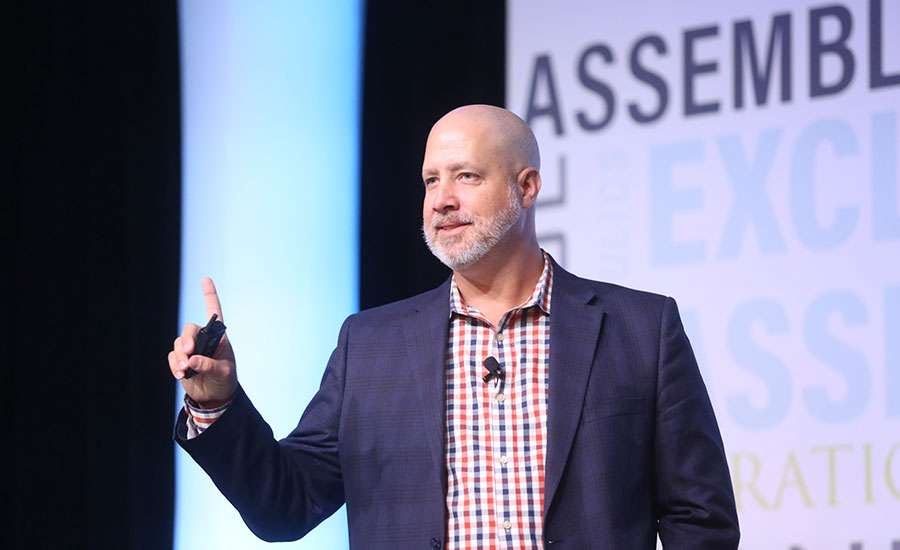
The show’s keynote address was presented by Roger Koenigsknecht, vice president of North American Connection Systems at Lear Corp. Photo by Brad Meese
“We use that data to make capital equipment decisions,” he says. “In the past, every plant got a capital budget. Managers would ask for equipment, but 90 percent of the time, they wouldn’t need it. With this data, we know exactly what we need.
“We have data for every day, every week, every month. It’s integral in how we move forward.”
Koenigsknecht emphasized that data collection doesn’t have to be complex or expensive. “Data gathering can be as simple as putting in a switch to indicate a task has been completed,” he says. “Then, you give people a target to achieve, and you put up a screen telling them how close they are to the target. That way, manufacturing becomes a competition.
“It’s small things like that that can take you to the next level. Everyone thinks they need to buy some expensive MES system. You don’t. It’s small things, small data.”
Koenigsknecht also noted that people are as important as technology. “You can collect the data, but if you don’t have the right people analyzing and pushing that data forward, you’re going to be in trouble,” he says.
Prior to the keynote, ASSEMBLY presented Taylor Guitars with the 2023 Assembly Plant of the Year award. The company received an engraved crystal award and a commemorative banner.
The world-class plant was chosen because of its innovative use of automation, green manufacturing, process controls and vertical integration. The company has pioneered new guitar designs and construction techniques and it’s been out in front when it comes to developing and adopting production technology. The plant completes around 125 guitars a day, but it can make upwards of 180 guitars a day if demand spikes, which happened a few years ago during the COVID pandemic.
The award ceremony in Rosemont was attended by Chris Wellons, vice president of manufacturing at Taylor Guitars.
“Our blend of proprietary, innovative technology with impeccable hand-craftsmanship has led to unparalleled quality and consistency in the production of our guitars,” explains Wellons. “We have gone from a small, unknown company to one of the world’s largest producers of high-end acoustic guitars.”
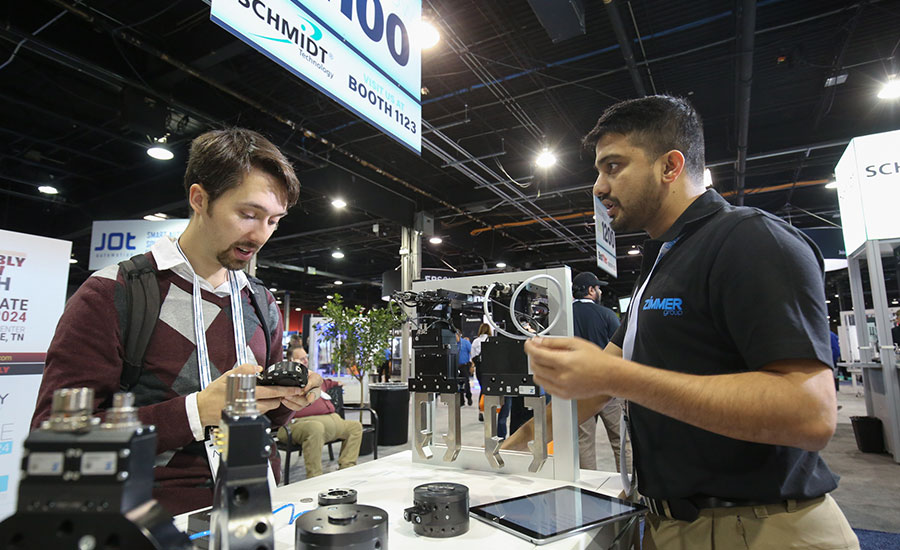
The ASSEMBLY Show hosted numerous robotic technology suppliers, including Zimmer, a manufacturer of grippers and other components. Photo by Brad Meese
Product of the Year Winners
To draw attention to the breadth and quality of new technologies on display at The ASSEMBLY Show, we again held a “Product of the Year” contest during the event.
Twenty innovative products were nominated in five categories. Attendees voted for their favorites via tablet computers at a special display on the show floor. Voting was open during the first two days of the show, and the winners were announced the morning of Thursday, Oct. 26.
In the “Assembly Machines and Systems” category, the winning product was a custom automated assembly system designed by MS Automation. Built to assemble a military-grade product, the system has the flexibility to process hundreds of part variants with no manual changeover.
Servo-actuated nests, tools, fixtures and robotic grippers with pressure-sensing feedback allow for immediate and automatic changeover between part variants. The automated flexibility is even more impressive considering the complexity and precision of the processes to assemble the product. A high-speed delta robot picks components from a custom multi-lane feeding system that uses coin-change singulation and automated inspection. Pins measuring just 1 millimeter across are automatically de-reeled and stitched into housings in precise locations. The final product is laser marked and coated with lubricant before final pack-out.
In the “Adhesives, Dispensing and Curing” category, the winning product was a new adhesive from Henkel Corp. Loctite Ablestik NCA 01UV is formulated for assembly of high-resolution cameras and lidar modules for advanced driver assistance systems. This active alignment adhesive is cured in a single step with just 3 seconds of exposure to UV LED light, eliminating the need for oven curing to save time, energy and CO₂ emissions.
With low and consistent dimensional change of 0.4 percent during cure, this adhesive can be used to assemble high-resolution camera modules. No outgassing from volatile compounds ensures high image quality and no fogging of optical components. It is free of CMT, SVHC, or any toxic substances and fully EU REACH-compliant.
A programmable, transducerized cordless screwdriver from Makita U.S.A. Inc. won the “Fastening Tools” category. Model DFT060TMZ has a torque range of 2 to 6 newton-meters. Model DFT120TMZ has a torque range of 4 to 12 newton-meters. The tool is equipped with an efficient Makita-built brushless motor, with a no-load speed of 400 to 1,300 rpm. Including the battery, the tool weighs just 2.4 pounds. A built-in LED light illuminates the work surface for better visibility in low-light environments.
The tool automatically shuts off when a preset torque is reached, and it provides both visual and audible feedback on each fastening operation. A USB connection allows for six-stage programming of both direction and speed control throughout the fastening process. The tools are certified for a repeatability of ±4 percent of mean torque.
The tool is powered by a 14.4-volt lithium-ion battery for extended run time and a greater number of lifetime charge cycles. The tool is automatically disabled once battery capacity drops below 5 percent. The battery recharges in only 30 minutes.
The most popular product in the “Robotics” category was the MIRAI control system from Micropsi Industries GmbH. MIRAI enables robots to handle variance in shape, position, color and light conditions in the work space. Using AI, MIRAI generates robot movements in real time and can respond automatically to movements of the target object. MIRAI takes control of the first and last centimeters of the robot’s path, eliminating the need for rigid fixturing of parts.
MIRAI also simplifies the task of robot programming. Robots equipped with MIRAI are able to learn many tasks through observation, so they can easily be trained and retrained for various process steps. No knowledge of programming or AI is required.
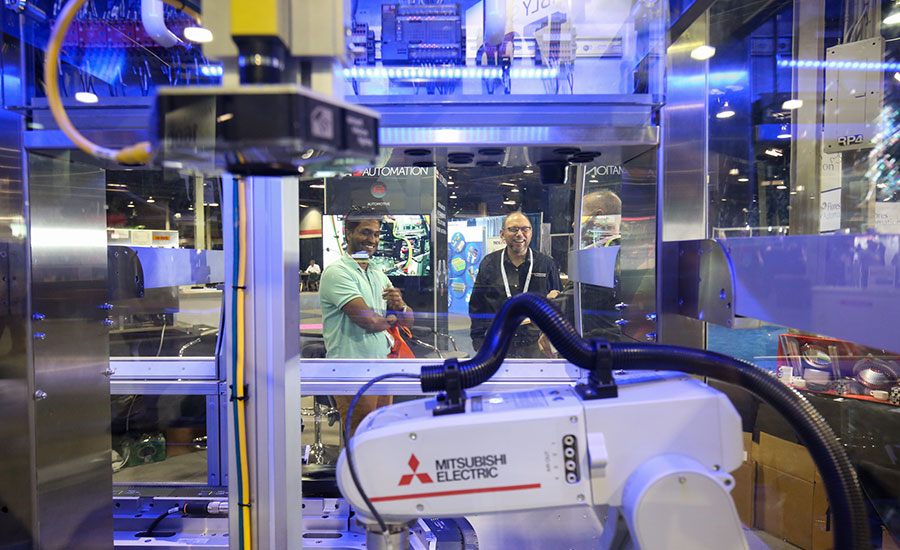
Engineers looking to automate various assembly processes found plenty of help at the ASSEMBLY Show. Photo by Brad Meese
The system consists of a MIRAI controller; a six-axis robot (supplied by FANUC or Universal Robots); a force-torque sensor; an end effector; a camera (supplied by Micropsi Industries); and a ring-light.
MIRAI augments the robot’s native controller, enabling the machine to perceive its work environment. Through AI, MIRAI-enabled robots observe actions performed by a person and then imitate those actions. Observations are recorded by a camera attached to the robot’s wrist or situated at a fixed position proximate to the workspace. To train the robot, a person performs and records repeated demonstrations of a task by manually guiding the robot by the robot’s wrist. The recordings are then transformed into a vision-based, real-time robot control schema.
In the “Factory of the Future” category, the winning product was Canvas Envision Creator software from Canvas GFX Inc.
Product lifecycle management (PLM) software is the single source of truth for all product data. PLM underpins the digital thread, informs other core systems such as ERP and MES, and ensures critical business processes are managed and optimized according to the most current data.
Manufacturers now need to make that data truly work for them, by extending the digital thread to the front line workers responsible for production and output. Canvas Envision integrates with Aras Innovator PLM, enabling anyone within an organization to create and consume interactive digital instructional documents that leverage up-to-the minute design data.
Design engineering generates huge volumes of data. PLM does the plumbing; it keeps track of versions, sends data to the right places, and is great at orchestrating workflows. And it lets engineers visualize 3D CAD. But PLM won’t let manufacturers take the 10 or 15 other sources of data it houses and rapidly aggregate them, along with CAD data, into intuitive and easy-to-consume content that meets the unique contextual requirements of all the stakeholders in manufacturing.
Canvas Envision Creator does that. It’s a powerful and easy-to-use desktop graphics application that gives everyone the ability to leverage 3D CAD models to create interactive visual documents. With Envision, manufacturers get easy to use 3D visualization combined with text layout, 2D drawing tools, vector graphics and photo editing, and a host of smart tools and features to help them visually communicate key information about their products.
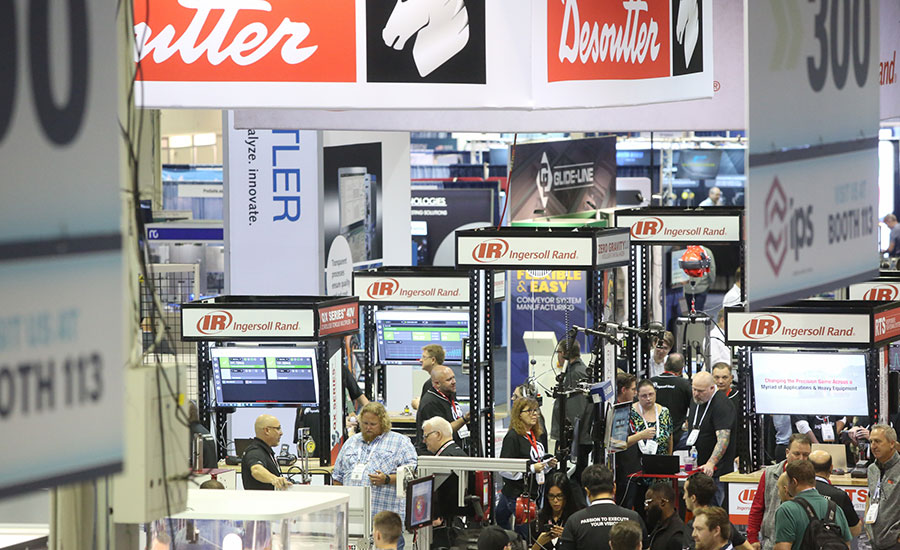
The show featured 223 exhibitors spread across more than 62,000 square feet of floor space. Photo by Brad Meese
What’s Next
Next year’s ASSEMBLY Show will be held Oct. 22-24, 2024. For more information, visit www.theassemblyshow.com. In 2024, SMTA International, conference and trade show dedicated to electronics assembly and engineering, will co-locate with The ASSEMBLY Show.
The 2nd annual ASSEMBLY Show South will take place April 30-May 2 at the Music City Center in Nashville, TN. The event will be co-located with The QUALITY Show South for the first time.


